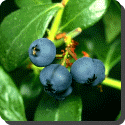 Blueberry — Blueberries are flowering plants in the genus Vaccinium, sect. Cyanococcus. The species are native only to North America. They are shrubs varying in size from 10 cm tall to 4 m tall; the smaller species are known as “lowbush blueberries”, and the larger species as “highbush blueberries”. The leaves can be either deciduous or evergreen, ovate to lanceolate, and from 1-8 cm long and 0.5-3.5 cm broad. The flowers are bell-shaped, white, pale pink or red, sometimes tinged greenish.
Blueberry — Blueberries are flowering plants in the genus Vaccinium, sect. Cyanococcus. The species are native only to North America. They are shrubs varying in size from 10 cm tall to 4 m tall; the smaller species are known as “lowbush blueberries”, and the larger species as “highbush blueberries”. The leaves can be either deciduous or evergreen, ovate to lanceolate, and from 1-8 cm long and 0.5-3.5 cm broad. The flowers are bell-shaped, white, pale pink or red, sometimes tinged greenish.
The fruit is a false berry 5-16 mm diameter with a flared “crown” at the end; they are pale greenish at first, then reddish-purple, and finally indigo on ripening. They have a sweet taste when mature, with variable acidity. Blueberry bushes typically bear fruit from May through October; “blueberry season” peaks in July, which is National Blueberry Month in the United States and Canada.
All species whose English common names include “blueberry” are currently classified in section Cyanococcus of the genus Vaccinium. Several other plants of the genus Vaccinium also produce blue berries which are sometimes confused with blueberries, mainly the predominantly European bilberry (Vaccinium myrtillus), which in many languages has a name that means “blueberry” in English.
Although blueberries are native to North America, they are now grown also in Australia, New Zealand and South American countries, and are air-shipped as fresh produce to markets around the world.
Beginning in 2005, blueberries have been discussed among a category of functional foods called superfruits having the favorable combination of nutrient richness, antioxidant strength, emerging research evidence for health benefits and versatility for manufacturing popular consumer products.
True wild blueberries (section Cyanococcus of the genus Vaccinium) occur only in eastern North America. Other sections in the genus, native to other parts of the world including western North America, Europe, and Asia, include other wild shrubs producing similar-looking edible berries such as huckleberries, cranberries, bilberries and cowberries. These are sometimes colloquially called blueberries and sold as blueberry jam or other products.
Blueberries are cultivated and picked wild. In North America, the most common cultivated species is V. corymbosum, the Northern Highbush Blueberries. Hybrids of this with other Vaccinium species adapted to southern U.S. climates are known collectively as Southern Highbush Blueberries.
Wild blueberries, smaller than cultivated ones, are prized for their intense color. The Lowbush Blueberry, V. angustifolium, is found from Newfoundland westward and southward to Michigan and West Virginia. In some areas it produces natural blueberry barrens, where it is practically the only species covering large areas. Several First Nations communities in Ontario are involved in harvesting wild blueberries. Low bush species are fire-tolerant and blueberry production often increases following a forest fire as the plants regenerate rapidly and benefit from removal of competing vegetation.
 Kids Portal For Parents India Kids Network
Kids Portal For Parents India Kids Network






